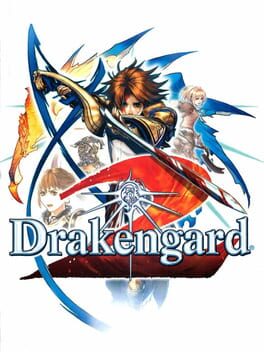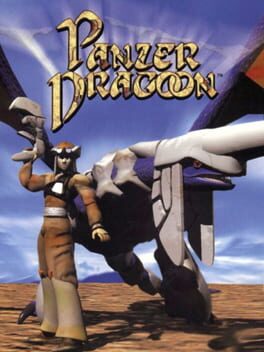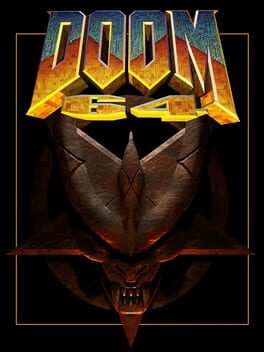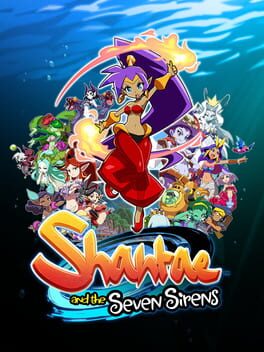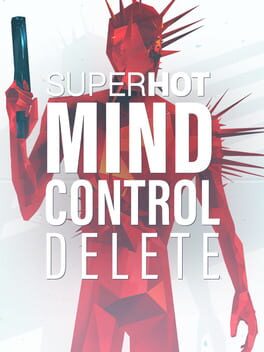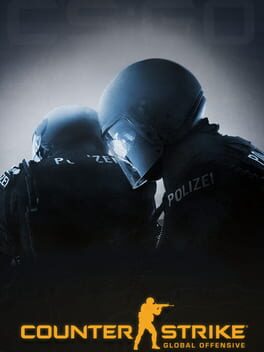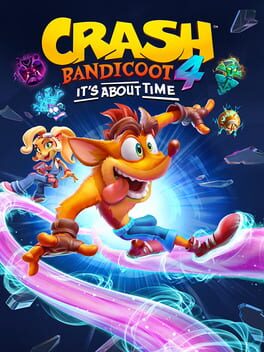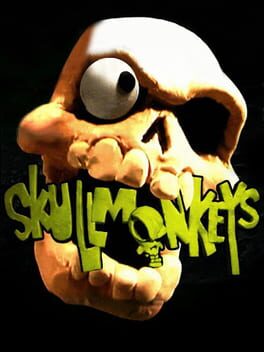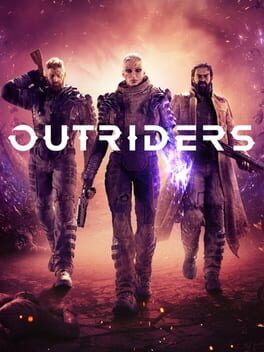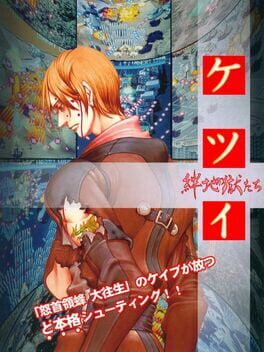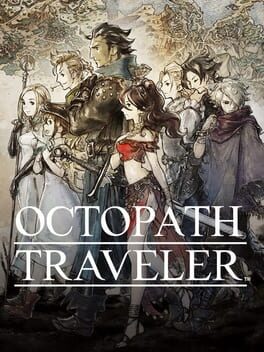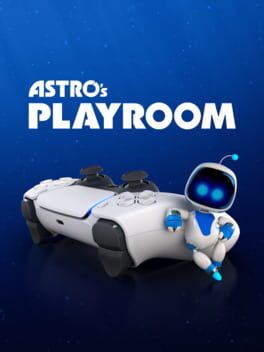Cold_Comfort
394 Reviews liked by Cold_Comfort
Metroid Fusion
2002
completely different design philosophy from the one seen in super metroid, but still it feels like not a sequence that does better or worse, but a complementation to metroid 3. it is less aesthetically oppressive but then samus don't have the amount of gadgets you used to have at the end of super metroid - but a virus does have and it is searching you. you don't have that amount of freedom in its level design, too, feeling way more like millimetric calculated segments. what this could be considered a "loss", i find pretty interesting and it is what made the game so special for me: it allows the player to feel full tension while being chased by SA-X and some exits and interconnections are very smartly implemented. the geography logic does less sense than super metroid but still, thinking in-universe, are just a bunch of different habitats in a research facility - by that, it does makes sense. also, i like the bosses! nightmare did live up to his name, probably the most difficult fight in the game but it is so well-made: the hitbox is horrendous but propositally, to make you feel really claustrophobic; as you shoot him, he'll cry until he reveals his gross face. i guess that this boss can say a lot of what metroid fusion search and, to me, accomplishes
Drakengard 2
2005
hi it's phil back for the game reviews for watchmojo.com i got another review for the- for you this time and this time it's gonna be called dra KEN gard not dragonguard that's dra KEN gard it's rated m for mature it's only for playstation 2 keep in mind this is a one player game there's no online possibilities there is the possibility of toning down the blood but god knows nobody tones down the blood so just forget about that.
this game is a mix of devils may cry action rpg where you have to constantly get your character's hp as we call it health power and magical power up as levels go up now keep in mind that this was made by ubisoft which is a very renowned company for games like this. now this is also offers you a great animations in terms of japanese animation and also effects in between scenes cinematics are a may zing uhh if i don't know if you're a fan of final fantasy or if you know these japanese animation kind of settings but this will offer you the same setting or maybe even more. i was very surprised with the outcome of the ps2 can offer on this game. nevertheless, i would consider you probably umm playing the first title before playing the second because i did not play the first title before and i was a little confused, nevertheless at the beginning of the game you get a little prologue of what previous game offered. now if you go into details into the game there is weapons you can accumulate, items, like any rpg game the idea is to constantly get your levels up so that your strength goes up so that obviously the game becomes easier and you're stronger.
now this was based in ... a magical world where ... you as a character ... named legna with your dragon end up taking over uhh the world and uhh trying to save different destinations with they're called keys, there's a total about six keys to take care of and they all have certain foes to fight to be able to take care of those keys. now, this is the kind of game where you get to the part where you think you're finishing it but there's always a little loop that makes you go on and on! now it's a total of twelve chapters and at the tenth chapter you think it's over but it's not. that's the beauty of the game.
now this is obviously like i've always said the best part of the show where i give mmmy opinion on dra KEN gard not dragonguard remember people there's dragons in this game but it's called dra KEN gard anyways let's just leave it at that. now all i have to say is ummm if you remember our legend i will repeat it again: 9 to 10 was a purchase where you keep the game because it's a-mazing. a 8 to 7 where it's a late rental fee because umm you think you can finish the game in one rental but then you realize that you have to rent it a second time so you end up renting it for seven days just to make sure. and the other one was 5 to 6 where... forget about it. you rent it uhhh maybe for one day and then you put it away and you never look at it again. just joking. nevertheless, i will place this game in 7 to 8 because it's very close to 9 to 10 but it's all seen before. umm very confusing because it gives you a lot of opportunities and a lot of side track missions and stuff like that that i don't really think that follows through the game. now a lot of people will maybe have a different opinion on this than me but i still think that the japanese factor thing of games are getting overwhelming, i mean for sony playstation 2 you can see 25 japanese animation titles come out while there's only one north american coming out at that time. i don't know if it's sony playstation is really more based or powerful in japan, god knows. but go on the website see for yourself, it's all written in japanese. i finished it in 56 hours the game was established to be finished in 85 hours, so it's up to you do your best to finish it but again i repeat myself: remember: it's just a game!
this game is a mix of devils may cry action rpg where you have to constantly get your character's hp as we call it health power and magical power up as levels go up now keep in mind that this was made by ubisoft which is a very renowned company for games like this. now this is also offers you a great animations in terms of japanese animation and also effects in between scenes cinematics are a may zing uhh if i don't know if you're a fan of final fantasy or if you know these japanese animation kind of settings but this will offer you the same setting or maybe even more. i was very surprised with the outcome of the ps2 can offer on this game. nevertheless, i would consider you probably umm playing the first title before playing the second because i did not play the first title before and i was a little confused, nevertheless at the beginning of the game you get a little prologue of what previous game offered. now if you go into details into the game there is weapons you can accumulate, items, like any rpg game the idea is to constantly get your levels up so that your strength goes up so that obviously the game becomes easier and you're stronger.
now this was based in ... a magical world where ... you as a character ... named legna with your dragon end up taking over uhh the world and uhh trying to save different destinations with they're called keys, there's a total about six keys to take care of and they all have certain foes to fight to be able to take care of those keys. now, this is the kind of game where you get to the part where you think you're finishing it but there's always a little loop that makes you go on and on! now it's a total of twelve chapters and at the tenth chapter you think it's over but it's not. that's the beauty of the game.
now this is obviously like i've always said the best part of the show where i give mmmy opinion on dra KEN gard not dragonguard remember people there's dragons in this game but it's called dra KEN gard anyways let's just leave it at that. now all i have to say is ummm if you remember our legend i will repeat it again: 9 to 10 was a purchase where you keep the game because it's a-mazing. a 8 to 7 where it's a late rental fee because umm you think you can finish the game in one rental but then you realize that you have to rent it a second time so you end up renting it for seven days just to make sure. and the other one was 5 to 6 where... forget about it. you rent it uhhh maybe for one day and then you put it away and you never look at it again. just joking. nevertheless, i will place this game in 7 to 8 because it's very close to 9 to 10 but it's all seen before. umm very confusing because it gives you a lot of opportunities and a lot of side track missions and stuff like that that i don't really think that follows through the game. now a lot of people will maybe have a different opinion on this than me but i still think that the japanese factor thing of games are getting overwhelming, i mean for sony playstation 2 you can see 25 japanese animation titles come out while there's only one north american coming out at that time. i don't know if it's sony playstation is really more based or powerful in japan, god knows. but go on the website see for yourself, it's all written in japanese. i finished it in 56 hours the game was established to be finished in 85 hours, so it's up to you do your best to finish it but again i repeat myself: remember: it's just a game!
NieR Replicant is a game about found family, about not fitting into the world around you but finding people who love you regardless, who make you stronger and as a result more able to love yourself, or at least bear yourself. It's a game is about family, and community. It's about what makes someone human, and where the line lies with regards to personhood. About whether lying is worth it to save people pain, if such lies are even capable of doing so. NieR Replicant is a game doused in moral ambiguity.
It's also a game that is deeply about the feeling of loss. The kind of loss that drives you on through the harshest opposition, that makes you reckless, or that causes you to lose all sight of what is going on around you. The kind of loss that leads to you not returning home for as long as you can because you can't cope with the idea of seeing that empty bed again, the kind that leaves the landscape feeling deeply scarred for what is no longer there. The kind of gut-wrenching loss such that you can't bring yourself to repair the massive hole wrought upon your ceiling, even years later, because doing so would feel almost disrespectful to the fallen, because you can't bring yourself to accept that sometimes healing and letting go have to come hand-in-hand.
On a more subtle level, I can't help but feel that NieR Replicant is also a game about games, about the potential for the medium, about narrative, about iteration and the very concept of canon (or, how fickle canon is). The extent to which Replicant dives headlong into as many genres as it can is genuinely thrilling, with the introduction of the visual novel sections in the Forest of Myth being particularly startling, gorgeous and moving includes.
The biggest asset of the game however, beyond how moving it frequently is, beyond its earnestness, beyond this exuberant love of genre, is absolutely its cast. Kainé and Emil stand as two of the most deeply realised characters I've seen in any game, but even beyond this the cast at large has so many lovable characters, even many of the relatively minor ones, which is why even many of the game's smaller emotional beats still ring true and leave such an impact.
I will say that for all this NieR Replicant is a very imperfect, even downright frustrating, game sometimes. The story is honestly just kind of a mess in some regards, many of the sub-quests and even parts of the main quest feature gross amounts of being sent from Place A to Place B only to have the person there send you back to Place A where someone else sends you back to Place B again, and the structure of the extra routes/endings is very repetitive with Route C descending into a tedious grind that saps all but the very best moments in the bulk of this route of their emotional impact.
And yet whilst these flaws meant that it's hard for me to personally place Replicant alongside Automata, I find myself loving the game an awful lot. Replicant is a game of intense artistic ambition and of relentless heart, and so even though the low-points had me wishing that the late-game was even slightly more streamlined it's hard not to leave the experience feeling well-nourished.
It's also a game that is deeply about the feeling of loss. The kind of loss that drives you on through the harshest opposition, that makes you reckless, or that causes you to lose all sight of what is going on around you. The kind of loss that leads to you not returning home for as long as you can because you can't cope with the idea of seeing that empty bed again, the kind that leaves the landscape feeling deeply scarred for what is no longer there. The kind of gut-wrenching loss such that you can't bring yourself to repair the massive hole wrought upon your ceiling, even years later, because doing so would feel almost disrespectful to the fallen, because you can't bring yourself to accept that sometimes healing and letting go have to come hand-in-hand.
On a more subtle level, I can't help but feel that NieR Replicant is also a game about games, about the potential for the medium, about narrative, about iteration and the very concept of canon (or, how fickle canon is). The extent to which Replicant dives headlong into as many genres as it can is genuinely thrilling, with the introduction of the visual novel sections in the Forest of Myth being particularly startling, gorgeous and moving includes.
The biggest asset of the game however, beyond how moving it frequently is, beyond its earnestness, beyond this exuberant love of genre, is absolutely its cast. Kainé and Emil stand as two of the most deeply realised characters I've seen in any game, but even beyond this the cast at large has so many lovable characters, even many of the relatively minor ones, which is why even many of the game's smaller emotional beats still ring true and leave such an impact.
I will say that for all this NieR Replicant is a very imperfect, even downright frustrating, game sometimes. The story is honestly just kind of a mess in some regards, many of the sub-quests and even parts of the main quest feature gross amounts of being sent from Place A to Place B only to have the person there send you back to Place A where someone else sends you back to Place B again, and the structure of the extra routes/endings is very repetitive with Route C descending into a tedious grind that saps all but the very best moments in the bulk of this route of their emotional impact.
And yet whilst these flaws meant that it's hard for me to personally place Replicant alongside Automata, I find myself loving the game an awful lot. Replicant is a game of intense artistic ambition and of relentless heart, and so even though the low-points had me wishing that the late-game was even slightly more streamlined it's hard not to leave the experience feeling well-nourished.
Panzer Dragoon
1995
After a strong feeling of listlessness that prevented me from really playing much new, I pushed myself through an hour of saturn emulation config bullshit to finally kickstart my ass into this series. I did make sure to take a break before starting, lest my frustration with getting everything set up to begin with color any of this experience.
The result? Hmm.
Definitely has the charm of what I guess is somewhere in between tech demo and concept album, and well it has dragons in it so I guess I can't complain too much, but what is here is still an extremely scuffed rail shooter to play.
I don't mean from really a mechanical perspective, although that part is only moderately interesting there, I mean from a visual one. Processing the low resolution obstacles required a lot of squinting from my end and there was so many things that hit me that I couldn't tell what did at first. It's very coarse rough sandpaper to just feel through, with lightly sharp edges. I don't enjoy playing with it, but there's certainly some neat feeling to rub against the sandpaper initially.
In conclusion though, I finished stage 4 where I fought a large mech that had some cool animations, and then I decided that maybe this isn't the game I should be playing to try to get back into things at all, as I'm not feeling an ounce of much satisfaction or fun from this history piece. I don't recommend playing it, personally.
The result? Hmm.
Definitely has the charm of what I guess is somewhere in between tech demo and concept album, and well it has dragons in it so I guess I can't complain too much, but what is here is still an extremely scuffed rail shooter to play.
I don't mean from really a mechanical perspective, although that part is only moderately interesting there, I mean from a visual one. Processing the low resolution obstacles required a lot of squinting from my end and there was so many things that hit me that I couldn't tell what did at first. It's very coarse rough sandpaper to just feel through, with lightly sharp edges. I don't enjoy playing with it, but there's certainly some neat feeling to rub against the sandpaper initially.
In conclusion though, I finished stage 4 where I fought a large mech that had some cool animations, and then I decided that maybe this isn't the game I should be playing to try to get back into things at all, as I'm not feeling an ounce of much satisfaction or fun from this history piece. I don't recommend playing it, personally.
This review contains spoilers
you know, i understand now why we're twins. it's because... because we were born without souls. this world is too lonely for one without a soul. there's too much... emptiness. our souls are missing, but our tears still work.
devola’s last words are a resume of the entire game. vessels without souls and souls without vessels. they fight, but they have something in common: they are empty. they, in theory, need one another. but they can’t. replicants now have sentience, they see gestalts as menaces, they fight them, they kill them. the two of them, however, have one more thing in common: they get together to fill themselves. the conscious beings in nier replicant’s world all have their own problems that go beyond the “replicants vs gestalt war”. they suffer, searching desperately for acceptance, for meaning in their lives, for identity - and this search is seen by the game itself, constantly changing its shape, as if something was missing (it's the game body or the game soul?), but in the end, this search is what brings hope, is what brings meaning. the characters in nier replicant may be selfish (i mean, the boy kills the shadowlord and basically the entire humanity together), looking further into their own objectives without thinking in the whole picture, but, at the end of the world, would you try to save it or just be together with the ones you love?
devola’s last words are a resume of the entire game. vessels without souls and souls without vessels. they fight, but they have something in common: they are empty. they, in theory, need one another. but they can’t. replicants now have sentience, they see gestalts as menaces, they fight them, they kill them. the two of them, however, have one more thing in common: they get together to fill themselves. the conscious beings in nier replicant’s world all have their own problems that go beyond the “replicants vs gestalt war”. they suffer, searching desperately for acceptance, for meaning in their lives, for identity - and this search is seen by the game itself, constantly changing its shape, as if something was missing (it's the game body or the game soul?), but in the end, this search is what brings hope, is what brings meaning. the characters in nier replicant may be selfish (i mean, the boy kills the shadowlord and basically the entire humanity together), looking further into their own objectives without thinking in the whole picture, but, at the end of the world, would you try to save it or just be together with the ones you love?
Doom 64
1997
Doom 64 can be best described as "inoffensively OK". I do prefer it over the rather basic level design in most of Doom 1 and the creative but quality-wise inconsistent Doom 2, although there was definitely a lot more Doom 64 could have done with its enemy roster, even if the Chaingunner/Archvile/Revenant were cut due time/technical constraints. This becomes clearer after playing the new The Lost Levels add-on (seven new levels that were included in the rerelease of Doom 64 on modern platforms), which is a noticeable step up compared to the original campaign in terms of visual detail and encounter design, for reasons I will get into a bit later.
The most standout thing about Doom 64 compared to other Dooms is its psychological horror atmosphere, one that's more in the vein of Quake 1 than Doom 3 with its jumpscares. So Doom 64's color palette is darker and more desaturated (while still being willing to use primary colors unlike Quake 1 and its endless Brown), but it's the oppressive dark ambient soundtrack that really hard-carries Doom 64's atmosphere. It's not even an understatement to say that the soundtrack is the atmosphere. It fits unsurprisingly well with continuously slaughtering demons by the hundreds in abstract industrial/hell-mazes without ever stopping to take a break. I find myself wishing that Doom would lean into the psychological horror more from a narrative and level design perspective as well (without turning the gameplay into a generic corridor shooter á la Doom 3), because as it stands the horror is exchangeable window dressing. But damn it's some good window dressing.
In terms of the new models and animations in Doom 64, it's kind of a mixed bag. I don't have an issue with the enemy sprites being pre-rendered early 90's 3D as opposed to the scanned clay models of the original, but a lot of expression has been lost on the new enemies. You can barely make out the angry grimaces on enemies like Zombiemen, Imps, and Mancubi, which did a lot to give them some extra personality. On the other hand, the redesign of the Arachnotron feels like a straight upgrade (its design was even used as the base for Doom Eternal's Arachnotron), making it looks more murderous and lethal that's better in line with its role in combat than the goofy "fatman on a chair" look it had in the originals. The biggest loss by far are the new shotgun reload "animations", which instead of the legendary original reload animations now just do the Quake 1 thing of moving the shotgun sprite back and forth. On the other hand, the Chainsaw now has twin chainsaw blades. It deals the same damage as the original, but it is twice as cool now.
Doom 64 plays near-identically to the first two Dooms, but there have been some tweaks. The SSG has a slightly higher RoF (1.77s -> 1.53s), and Cacodemons now consistently go down in two instead of three SSG blasts when the RNG felt like screwing you over. This helps speed things up in parts where there's not a major challenge going on (like fighting lone Hell Knights in tight corridors or the clean-up phase of a major fight where you're finishing off the last heavy demons) without making stronger weapons like the Plasma Rifle or Rocket Launcher useless, so I do welcome this change. You can no longer prevent Pain Elementals from spawning Lost Souls by hugging their face, now you will take a rocket's worth of damage if you try to do that. A new weapon has been introduced called the Unmaker, which on its own is like a hitscan Plasma Rifle and a redundant addition to your arsenal, but becomes an OP joke weapon once upgraded. You're better off pistol starting each level (yes, all Doom 64 levels are designed around pistol starts, and for maximum enjoyment you should play with pistol starts as well) so you don't have to pretend you can't just Unmaker your way out of a tight spot.
There are no new enemies in Doom 64 (not counting the Mother Demon), aside from the Nightmare Imp, which is an Imp reskin that moves twice as fast and throws out fireballs that move twice as fast, but I do dig its inclusion on paper. On paper this allows regular Imps to pose more of a macro-level threat with their slow fireballs cutting off your movement in the long-term, whereas the faster Nightmare Imp fireballs create micro-level threats that you need to immediately evade. In practice this distinction is kind of pointless since Imp fireballs are small and easily avoidable either way, and Arachnotrons, Mancubi, hitscanners and Revenants (if Doom 64 had 'em) are generally a better fit for that kind of setup anyways.
Lost Souls have been changed the most, they charge much faster and attack more frequently, but (thankfully) now take only one instead of two shotgun shots to take down. In a vacuum, I do prefer this change of Lost Souls being a high-threat enemy that screw you over harder but are easier to kill (outside of Lost Souls becoming unable to move around corners because of how frequently they try to charge at you in a straight line), as opposed to a tankier annoyance that always came in large numbers and took a noticeable amount of time to get rid of. The problem is how this change affects Pain Elementals. A weaker Lost Soul means Pain Elementals also pose less of a threat, which you could stunlock more effortlessly. This is probably why the Pain Elemental in Doom 64 now spawns two Lost Souls at once instead of one. However, this opens yet another can of worms, especially when the Pain Elemental is triggered into infighting (something more likely to happen in D64 since a Pain Elemental failing to spawn Lost Souls can now damage other nearby demons). At best, you get lucky and manage to kill the Pain Elemental with two rockets before it spawns two super-sonic Lost Souls that are in your face the next frame and cause your rocket to blow up in your face. At worst, the game grinds down to a halt as the sheer amount of coked-up Lost Souls create so much unpredictability that picking them off from a safe corner becomes the only viable survival tactic. Not that this never happened in the originals, but there Pain Elementals didn't tend to escalate things as fast. When looking at the Lost Soul changes in the grander scheme of things, I do prefer the original implementation, as it doesn't make fighting Pain Elementals as much of a chaotic fustercluck.
Doom 64's level design usually doesn't do stuff that's downright offensive (f.e. death pits, giving you almost no breathing room against an enemy horde, surrounding you with hitscanners, etc.), but at the same time its combat encounters aren't particularly outstanding. There's a general lack of time/space pressure in most encounters (i.e. being given too much space to move around in and/or there being not enough enemies to restrict that space), nor is there much of a Double Impact-style resource management pressure to justify the overall laidback intensity of the levels (doubly so if you are playing without pistol starts). Aside from that is the EXTREME overreliance on Hell Knights/Barons, especially in the "do the SSG dance against one or two Knights/Barons in a tight corridor" setup that gets reused for about a hundred times with little variation. I don't believe that the absence of the Revenant/Archvile is the cause here, because you can still get some good mileage off Arachnotrons and Mancubi (as The Lost Levels show). This brings me to my second point, which is that Arachnotrons and Mancubi are woefully underutilized in the main campaign. In the main campaign they primarily appear in some of the later levels and most of the climax setpiece levels (Dead Simpler, Cat and Mouse, Watch Your Step), but for most of the game it's Knights/Barons, (Nightmare) Imps, Pinkies, and Cacodemons. Even then Pinkies/Cacos are used similarly to the Knight/Barons where the winning strategy is doing the SSG dance while slowly moving backwards. Usually Pain Elementals, now an Archvile-level threat, and Lost Souls will be deployed to shake things up Although as I stated before, I have mixed feelings about them.
The Lost Levels fare a lot better level design-wise. So (Nightmare) Imps tend to be more effectively utilized for long-range harassment, the levels are more willing to make you fight demons from multiple directions, Arachnotrons tend to be used more often as turrets and just in general, and Knights/Barons aren't spammed as much. There are some tedious parts, like the blue key room in Thy Glory and the room design making you slowly take out major enemies one by one, but not every map can be a winner. Overall, definitely a good inclusion for Doom 64. For those who are interested, my favourite maps would be map 9, 15, 16, 22, 34, 35, and 37.
In terms of navigation, Doom 64's levels do have a tendency to fall in the "go backtrack and find out what this switch opened on the other side of the level" trap, where at best you find the newly opened gate or door by accident, and at worst you're running circles in an empty level trying to find out where to go next. The navigation in Doom serves to create small navigation puzzles between fights to keep players from tiring out (much like the platforming in Doom Eternal); it shouldn't be what you end up spending most of your playtime on. To prevent this, colored keycards should be used when the distance between a switch/key and the corresponding gate is large, as colored gates are easier to remember as a place you need to eventually go to, than if it were a locked generic door. But since Doom only supports three keycard colors (and because the more you add, the harder it gets to keep track of these colored gates), regular switches should be used when the distance between a switch and a corresponding locked gate is short. Alternatively, extra enemies can be spawned in to form a breadcrumb trail towards the now-opened gate, or the corresponding gate can be placed in your line of sight when hitting its switch. Not to say that Doom 64 never does this, but it's not always consistent in doing so. So there is even one level in Doom 64 which has an interactable Build Engine-style camera to show you what just opened in another part of the level.
Overall, a decent map pack. Try it out if you want to see what playing Doom with a Quake atmosphere feels like.
The most standout thing about Doom 64 compared to other Dooms is its psychological horror atmosphere, one that's more in the vein of Quake 1 than Doom 3 with its jumpscares. So Doom 64's color palette is darker and more desaturated (while still being willing to use primary colors unlike Quake 1 and its endless Brown), but it's the oppressive dark ambient soundtrack that really hard-carries Doom 64's atmosphere. It's not even an understatement to say that the soundtrack is the atmosphere. It fits unsurprisingly well with continuously slaughtering demons by the hundreds in abstract industrial/hell-mazes without ever stopping to take a break. I find myself wishing that Doom would lean into the psychological horror more from a narrative and level design perspective as well (without turning the gameplay into a generic corridor shooter á la Doom 3), because as it stands the horror is exchangeable window dressing. But damn it's some good window dressing.
In terms of the new models and animations in Doom 64, it's kind of a mixed bag. I don't have an issue with the enemy sprites being pre-rendered early 90's 3D as opposed to the scanned clay models of the original, but a lot of expression has been lost on the new enemies. You can barely make out the angry grimaces on enemies like Zombiemen, Imps, and Mancubi, which did a lot to give them some extra personality. On the other hand, the redesign of the Arachnotron feels like a straight upgrade (its design was even used as the base for Doom Eternal's Arachnotron), making it looks more murderous and lethal that's better in line with its role in combat than the goofy "fatman on a chair" look it had in the originals. The biggest loss by far are the new shotgun reload "animations", which instead of the legendary original reload animations now just do the Quake 1 thing of moving the shotgun sprite back and forth. On the other hand, the Chainsaw now has twin chainsaw blades. It deals the same damage as the original, but it is twice as cool now.
Doom 64 plays near-identically to the first two Dooms, but there have been some tweaks. The SSG has a slightly higher RoF (1.77s -> 1.53s), and Cacodemons now consistently go down in two instead of three SSG blasts when the RNG felt like screwing you over. This helps speed things up in parts where there's not a major challenge going on (like fighting lone Hell Knights in tight corridors or the clean-up phase of a major fight where you're finishing off the last heavy demons) without making stronger weapons like the Plasma Rifle or Rocket Launcher useless, so I do welcome this change. You can no longer prevent Pain Elementals from spawning Lost Souls by hugging their face, now you will take a rocket's worth of damage if you try to do that. A new weapon has been introduced called the Unmaker, which on its own is like a hitscan Plasma Rifle and a redundant addition to your arsenal, but becomes an OP joke weapon once upgraded. You're better off pistol starting each level (yes, all Doom 64 levels are designed around pistol starts, and for maximum enjoyment you should play with pistol starts as well) so you don't have to pretend you can't just Unmaker your way out of a tight spot.
There are no new enemies in Doom 64 (not counting the Mother Demon), aside from the Nightmare Imp, which is an Imp reskin that moves twice as fast and throws out fireballs that move twice as fast, but I do dig its inclusion on paper. On paper this allows regular Imps to pose more of a macro-level threat with their slow fireballs cutting off your movement in the long-term, whereas the faster Nightmare Imp fireballs create micro-level threats that you need to immediately evade. In practice this distinction is kind of pointless since Imp fireballs are small and easily avoidable either way, and Arachnotrons, Mancubi, hitscanners and Revenants (if Doom 64 had 'em) are generally a better fit for that kind of setup anyways.
Lost Souls have been changed the most, they charge much faster and attack more frequently, but (thankfully) now take only one instead of two shotgun shots to take down. In a vacuum, I do prefer this change of Lost Souls being a high-threat enemy that screw you over harder but are easier to kill (outside of Lost Souls becoming unable to move around corners because of how frequently they try to charge at you in a straight line), as opposed to a tankier annoyance that always came in large numbers and took a noticeable amount of time to get rid of. The problem is how this change affects Pain Elementals. A weaker Lost Soul means Pain Elementals also pose less of a threat, which you could stunlock more effortlessly. This is probably why the Pain Elemental in Doom 64 now spawns two Lost Souls at once instead of one. However, this opens yet another can of worms, especially when the Pain Elemental is triggered into infighting (something more likely to happen in D64 since a Pain Elemental failing to spawn Lost Souls can now damage other nearby demons). At best, you get lucky and manage to kill the Pain Elemental with two rockets before it spawns two super-sonic Lost Souls that are in your face the next frame and cause your rocket to blow up in your face. At worst, the game grinds down to a halt as the sheer amount of coked-up Lost Souls create so much unpredictability that picking them off from a safe corner becomes the only viable survival tactic. Not that this never happened in the originals, but there Pain Elementals didn't tend to escalate things as fast. When looking at the Lost Soul changes in the grander scheme of things, I do prefer the original implementation, as it doesn't make fighting Pain Elementals as much of a chaotic fustercluck.
Doom 64's level design usually doesn't do stuff that's downright offensive (f.e. death pits, giving you almost no breathing room against an enemy horde, surrounding you with hitscanners, etc.), but at the same time its combat encounters aren't particularly outstanding. There's a general lack of time/space pressure in most encounters (i.e. being given too much space to move around in and/or there being not enough enemies to restrict that space), nor is there much of a Double Impact-style resource management pressure to justify the overall laidback intensity of the levels (doubly so if you are playing without pistol starts). Aside from that is the EXTREME overreliance on Hell Knights/Barons, especially in the "do the SSG dance against one or two Knights/Barons in a tight corridor" setup that gets reused for about a hundred times with little variation. I don't believe that the absence of the Revenant/Archvile is the cause here, because you can still get some good mileage off Arachnotrons and Mancubi (as The Lost Levels show). This brings me to my second point, which is that Arachnotrons and Mancubi are woefully underutilized in the main campaign. In the main campaign they primarily appear in some of the later levels and most of the climax setpiece levels (Dead Simpler, Cat and Mouse, Watch Your Step), but for most of the game it's Knights/Barons, (Nightmare) Imps, Pinkies, and Cacodemons. Even then Pinkies/Cacos are used similarly to the Knight/Barons where the winning strategy is doing the SSG dance while slowly moving backwards. Usually Pain Elementals, now an Archvile-level threat, and Lost Souls will be deployed to shake things up Although as I stated before, I have mixed feelings about them.
The Lost Levels fare a lot better level design-wise. So (Nightmare) Imps tend to be more effectively utilized for long-range harassment, the levels are more willing to make you fight demons from multiple directions, Arachnotrons tend to be used more often as turrets and just in general, and Knights/Barons aren't spammed as much. There are some tedious parts, like the blue key room in Thy Glory and the room design making you slowly take out major enemies one by one, but not every map can be a winner. Overall, definitely a good inclusion for Doom 64. For those who are interested, my favourite maps would be map 9, 15, 16, 22, 34, 35, and 37.
In terms of navigation, Doom 64's levels do have a tendency to fall in the "go backtrack and find out what this switch opened on the other side of the level" trap, where at best you find the newly opened gate or door by accident, and at worst you're running circles in an empty level trying to find out where to go next. The navigation in Doom serves to create small navigation puzzles between fights to keep players from tiring out (much like the platforming in Doom Eternal); it shouldn't be what you end up spending most of your playtime on. To prevent this, colored keycards should be used when the distance between a switch/key and the corresponding gate is large, as colored gates are easier to remember as a place you need to eventually go to, than if it were a locked generic door. But since Doom only supports three keycard colors (and because the more you add, the harder it gets to keep track of these colored gates), regular switches should be used when the distance between a switch and a corresponding locked gate is short. Alternatively, extra enemies can be spawned in to form a breadcrumb trail towards the now-opened gate, or the corresponding gate can be placed in your line of sight when hitting its switch. Not to say that Doom 64 never does this, but it's not always consistent in doing so. So there is even one level in Doom 64 which has an interactable Build Engine-style camera to show you what just opened in another part of the level.
Overall, a decent map pack. Try it out if you want to see what playing Doom with a Quake atmosphere feels like.
Compared to Half Genie Hero's hub-based level design, Seven Sirens shifts into a singular metroidvania world map, and I'd be lying if I said that this has done Shantae any favours.
Where the isolated stages used to provide a sense of theming, helping the world feel cogniscantly designed with particular mechanics and visuals in mind, each acting as engaging steps in your overall journey - Seven Sirens is happy to be a sweeping topography of almost amateurish, vaguely comprised rooms using palette swaps and clashing assets, spending the majority of the playtime in claustrophobic spaces enclosed by sewer and cave walls of only minor variation. The game is mercifully short, which is nice because I found myself lost and bored numerous times in the labyrinth of repeating room layouts.
Wayforward are about as good as it gets at capturing the feeling of a game that belongs on like, the Nintendo DS, and I'm sure part of the appeal is the overall simplicity, but it can play into why I rarely find any of their games all that engaging. Seven Sirens is essentially a track back to the school of Risky's Revenge or something.
Worth noting that, also compared to Half Genie Hero, this ~wasn't~ Kickstarter funded, so the relatively slim levels of quality and content may be explained away as there simply being less on the line.
Liked the Studio Trigger intro though!!
Where the isolated stages used to provide a sense of theming, helping the world feel cogniscantly designed with particular mechanics and visuals in mind, each acting as engaging steps in your overall journey - Seven Sirens is happy to be a sweeping topography of almost amateurish, vaguely comprised rooms using palette swaps and clashing assets, spending the majority of the playtime in claustrophobic spaces enclosed by sewer and cave walls of only minor variation. The game is mercifully short, which is nice because I found myself lost and bored numerous times in the labyrinth of repeating room layouts.
Wayforward are about as good as it gets at capturing the feeling of a game that belongs on like, the Nintendo DS, and I'm sure part of the appeal is the overall simplicity, but it can play into why I rarely find any of their games all that engaging. Seven Sirens is essentially a track back to the school of Risky's Revenge or something.
Worth noting that, also compared to Half Genie Hero, this ~wasn't~ Kickstarter funded, so the relatively slim levels of quality and content may be explained away as there simply being less on the line.
Liked the Studio Trigger intro though!!
My god, what a success. I've never played a franchise revival that gets so much right. Toys For Bob have proven that they understand much of the original Crash trilogy's appeal and that the series still has plenty of wriggle room for growth that the subsequent Crash outings weren't inspired enough to capitalise on.
Linear corridor-pushing platforming is back to Crash again with a base moveset as shrunken down as it was in 2 more specifically. What ensues are levels that are meticulously and appropriately balanced towards tight and challenging platforming around your more limited toolset. The devs have said "When we think about hazards and enemies and how they’re distributed, they stream across in almost a rhythmic way, so we’ve been really focused on how do we maximize that and use that differentiation to really push Crash gameplay", and that much is demonstrated in how the game retains the core trilogy tenets while also being more momentum-based than before.
For variance, new masks are thrown into the mix with controlled segments that require you to make use of their unique abilities - as well as entire characters that control very differently from the heroes. This is about as welcome as this kind of shakeup could be, these levels being immediately more cognisantly put together than the more extraneous-feeling vehicle segments in Crash 3. It's so nice that they're rarely ever necessary for completion, too, if the player doesn't happen to be keen on the way any given side character's levels play out.
I'd be remiss not to mention how gorgeous the game is. Toys For Bob seemed like the right choice for Crash after their art team's stellar work on the Spyro Reignited trilogy - proving that they are essentially the masters of stage and character design, adding details and changes to the base work that make the world feel effervescent.
I LOVE what they've done with the character redesigns here, taking their old shapes and making them as stylised and expressive as the GPU can handle. Coco's new style is a particular standout; she's never looked this good. Cortex's taller design is quite enlightened too. It suits his character so perfectly for him to try and look as big as he thinks he is, only for him to be a wee rodent when anyone else in the cast enters the frame.
It feels almost cruel and unfair to compare 4 to the remake trilogy that came out just a few years prior, but it's worth noting how incredibly dated that game already looks. A remake mired in bizarre visual choices that, while all minor in the grand scheme of things, illustrates a full image of a team that doesn't know what to do with the paints provided. I wish I could embed images for comparison's sake, but please believe me when you can pinpoint any minute detail from 4 (the water, fire effects, character shadows, foliage, animation, the list goes on) to their direct counterpart in the remake to see it almost completely botched. It all sounds like nitpicking, and it is, but art is an art babye.
https://twitter.com/BeachEpisode/status/1382872345321291785
Where things get particularly interesting with Crash 4 is sadly also where my problems begin. If you were to go into 4 with the same completionist ethos as you would in the OG trilogy, you'd get chewed up and spat out by some senselessly cruel design choices that are actually quite baffling. Crash 4 should act as a case study for how much goodwill can be diminished by level after level of "fuck you", bosshi-like cruelty. Where 100%'ing a given Crash game used to simply add about five or so hours onto the total playtime as you aim for optional collectables, 4 is quite literally padded front and back, forcing you to play through each given level (twice), with an "N.verted" visual filter. Doubling the level count in the laziest way conceivable. This wouldn't be so bad if not for the fact that the levels in Crash 4 are considerably longer and more densely packed with crates than ever before. I have to specify; it's not so much the difficulty being the problem; the content surrounding the difficulty is so disproportionately bloated. Racking up tens of minutes in a single level as you try to break every crate you can as you scan every nook and cranny with a fine-tooth comb, only for you to come to the end of a level, one crate short, it's enough to knock a star off a total score (and it did).
One of Crash 4's best elements is how unpredictable it is from a pacing standpoint. There are numerous points where you think you're in the final runup to the end only for the trapdoor beneath you to fall out, revealing a whole new slew of levels. This would normally be quite exciting, if not for how easily you could get burnt out at any point by the game's padded nature, making it hard to savour how much of a rambling journey the game takes you on. Sure, you could ignore these side things and sprint to the ending. You'd definitely finish the game with a more positive take away than me! But I am a simple man who wants those unlockable skins.
While I'm effortposting far too much about this orange marsupial game, I might as well add that I love the interdimensional story this game is trying to tell. Its sense of humour gets me to a tee and is filled with very subtle winks to even the prior games that are now rendered "not canon". Cutscenes with incredible squash n stretch tex avery loony tunes esque animation that conveys character better than any game I've ever played. I love it to death.
Crash 4 is a fleshed out, wonderfully well-studied sequel. Built with a uniquely high grade of technical skill that is often diminished by design choices that can feel a little misguided. This is one of the most concrete building blocks I have ever played, and is one iteration away from complete perfection to my eyes. (Like... just make it so the checkpoint boxes tell you how many crates you missed. That would help SO MUCH). I'm hoping Toys For Bob continue pumping out wall to wall bangers now that Skylanders seems to have bitten the dust; they're more qualified than most to make gorgeous, satisfying and engaging platformers that are absolutely drenched in personality.
Linear corridor-pushing platforming is back to Crash again with a base moveset as shrunken down as it was in 2 more specifically. What ensues are levels that are meticulously and appropriately balanced towards tight and challenging platforming around your more limited toolset. The devs have said "When we think about hazards and enemies and how they’re distributed, they stream across in almost a rhythmic way, so we’ve been really focused on how do we maximize that and use that differentiation to really push Crash gameplay", and that much is demonstrated in how the game retains the core trilogy tenets while also being more momentum-based than before.
For variance, new masks are thrown into the mix with controlled segments that require you to make use of their unique abilities - as well as entire characters that control very differently from the heroes. This is about as welcome as this kind of shakeup could be, these levels being immediately more cognisantly put together than the more extraneous-feeling vehicle segments in Crash 3. It's so nice that they're rarely ever necessary for completion, too, if the player doesn't happen to be keen on the way any given side character's levels play out.
I'd be remiss not to mention how gorgeous the game is. Toys For Bob seemed like the right choice for Crash after their art team's stellar work on the Spyro Reignited trilogy - proving that they are essentially the masters of stage and character design, adding details and changes to the base work that make the world feel effervescent.
I LOVE what they've done with the character redesigns here, taking their old shapes and making them as stylised and expressive as the GPU can handle. Coco's new style is a particular standout; she's never looked this good. Cortex's taller design is quite enlightened too. It suits his character so perfectly for him to try and look as big as he thinks he is, only for him to be a wee rodent when anyone else in the cast enters the frame.
It feels almost cruel and unfair to compare 4 to the remake trilogy that came out just a few years prior, but it's worth noting how incredibly dated that game already looks. A remake mired in bizarre visual choices that, while all minor in the grand scheme of things, illustrates a full image of a team that doesn't know what to do with the paints provided. I wish I could embed images for comparison's sake, but please believe me when you can pinpoint any minute detail from 4 (the water, fire effects, character shadows, foliage, animation, the list goes on) to their direct counterpart in the remake to see it almost completely botched. It all sounds like nitpicking, and it is, but art is an art babye.
https://twitter.com/BeachEpisode/status/1382872345321291785
Where things get particularly interesting with Crash 4 is sadly also where my problems begin. If you were to go into 4 with the same completionist ethos as you would in the OG trilogy, you'd get chewed up and spat out by some senselessly cruel design choices that are actually quite baffling. Crash 4 should act as a case study for how much goodwill can be diminished by level after level of "fuck you", bosshi-like cruelty. Where 100%'ing a given Crash game used to simply add about five or so hours onto the total playtime as you aim for optional collectables, 4 is quite literally padded front and back, forcing you to play through each given level (twice), with an "N.verted" visual filter. Doubling the level count in the laziest way conceivable. This wouldn't be so bad if not for the fact that the levels in Crash 4 are considerably longer and more densely packed with crates than ever before. I have to specify; it's not so much the difficulty being the problem; the content surrounding the difficulty is so disproportionately bloated. Racking up tens of minutes in a single level as you try to break every crate you can as you scan every nook and cranny with a fine-tooth comb, only for you to come to the end of a level, one crate short, it's enough to knock a star off a total score (and it did).
One of Crash 4's best elements is how unpredictable it is from a pacing standpoint. There are numerous points where you think you're in the final runup to the end only for the trapdoor beneath you to fall out, revealing a whole new slew of levels. This would normally be quite exciting, if not for how easily you could get burnt out at any point by the game's padded nature, making it hard to savour how much of a rambling journey the game takes you on. Sure, you could ignore these side things and sprint to the ending. You'd definitely finish the game with a more positive take away than me! But I am a simple man who wants those unlockable skins.
While I'm effortposting far too much about this orange marsupial game, I might as well add that I love the interdimensional story this game is trying to tell. Its sense of humour gets me to a tee and is filled with very subtle winks to even the prior games that are now rendered "not canon". Cutscenes with incredible squash n stretch tex avery loony tunes esque animation that conveys character better than any game I've ever played. I love it to death.
Crash 4 is a fleshed out, wonderfully well-studied sequel. Built with a uniquely high grade of technical skill that is often diminished by design choices that can feel a little misguided. This is one of the most concrete building blocks I have ever played, and is one iteration away from complete perfection to my eyes. (Like... just make it so the checkpoint boxes tell you how many crates you missed. That would help SO MUCH). I'm hoping Toys For Bob continue pumping out wall to wall bangers now that Skylanders seems to have bitten the dust; they're more qualified than most to make gorgeous, satisfying and engaging platformers that are absolutely drenched in personality.
Skullmonkeys
1998
I wish Doug Tennapel a very log off. Just one of those Genesis-like platformers I personally can't stand, each level being a board of floating platforms that sprawls in every direction and only vaguely makes you feel like you're actually going anywhere.
Grew up a fan of The Neverhood and never really saw or heard anything from Skullmonkeys until this playthrough, so I was quite excited! Sadly this just kinda aint it. Wild how much is lost in the transition from point n click to platformer. Sacrificing animation tenets for the sake of having a character that controls wildly fast and snappy, and barely making any use of the claymation environments outside of the FMV cutscenes. It was uniquely disappointing to see Klaymen burst into a sprint and grind to a halt with barely any inbetween animation. The soundtrack talks the talk though, these tunes slap, thanks Terry.
Where Neverhood would immerse you as you drudge at a snail's pace across lovingly crafted playdough worlds and characters, Skullmonkeys is more contempt to breadcrumb you at a blistering pace to its anticlimactic end. You could tell me that this was a massively lower-budget production than what came before and not only would I believe you, it'd explain a lot. Sadly, this isn't a case where adversity bred creativity.
Grew up a fan of The Neverhood and never really saw or heard anything from Skullmonkeys until this playthrough, so I was quite excited! Sadly this just kinda aint it. Wild how much is lost in the transition from point n click to platformer. Sacrificing animation tenets for the sake of having a character that controls wildly fast and snappy, and barely making any use of the claymation environments outside of the FMV cutscenes. It was uniquely disappointing to see Klaymen burst into a sprint and grind to a halt with barely any inbetween animation. The soundtrack talks the talk though, these tunes slap, thanks Terry.
Where Neverhood would immerse you as you drudge at a snail's pace across lovingly crafted playdough worlds and characters, Skullmonkeys is more contempt to breadcrumb you at a blistering pace to its anticlimactic end. You could tell me that this was a massively lower-budget production than what came before and not only would I believe you, it'd explain a lot. Sadly, this isn't a case where adversity bred creativity.
Outriders
2021
Outriders is a game that when it hits its power fantasy feels great; gives you the Fast and Blast that peak Path of Exile or Diablo have where you’re just destroying waves of hapless foes and feeling all mighty for it. It is quite a shame that these moments are few and far between until you’ve almost beat the story and heavily gear locked; if your numbers aren’t big enough then no fun for you. The core design is Diablo with chest high walls (which you mostly get to ignore come late game) coupled with one of the worst, most misanthropic stories I’ve seen in modern gaming. Terrible writing and voice acting abounds with jokes that hit maybe twice in the whole game and would otherwise be embarrassing for a 13-year-old boy to author.
The character ability customization and build variety are evidence of a developer who hasn’t put much time into researching what others are doing in the space nor to find out what works and what doesn’t in a similar vein to Anthem’s screwups. The armor mod system is wonderful where you can swap out one of the two abilities on your armor or weapon for anything you’d previously unlocked. Sadly, the substat system means anything but the most basic of “make gun hit gud” build is extremely finnicky and reliant on the perfect set of stats and mods while still often not being as effective, turning the game largely into a shooting gallery instead of fun power testing ground. You also barely have enough class points to make any sort of decisions about your build, as the vast majority of your points just go to getting to your necessary capstone ability.
This isn’t even mentioning how buggy the game is, what with inventory wipes, crashes, and a non-functional multiplayer environment. Even the working parts often seem like they should be called bugs in any other game, where attack hitboxes don’t match up to the red circles on the ground, or said indicators are covered up by terrain or simply non-present. Telegraphs as to what to do to avoid attacks are often missing, the interrupt system is half baked nonsense, and the general vertical field of vision where you need to watch the ground while shooting evil birds in the air hardly works.
There’s potential under all this; when the game clicks and you start dropping meteors on burning enemies from your legendary shotgun it can feel wonderful. Even then the payoffs in terms of fun are too small and everything that surrounds it simply fails. Hidden nerf mechanics such as “downscaling” which punish you for gearing up, insane balance decisions from the developers, and the fact that basically everything else in the game is total garbage makes this a hard derec, don’t waste your time.
The character ability customization and build variety are evidence of a developer who hasn’t put much time into researching what others are doing in the space nor to find out what works and what doesn’t in a similar vein to Anthem’s screwups. The armor mod system is wonderful where you can swap out one of the two abilities on your armor or weapon for anything you’d previously unlocked. Sadly, the substat system means anything but the most basic of “make gun hit gud” build is extremely finnicky and reliant on the perfect set of stats and mods while still often not being as effective, turning the game largely into a shooting gallery instead of fun power testing ground. You also barely have enough class points to make any sort of decisions about your build, as the vast majority of your points just go to getting to your necessary capstone ability.
This isn’t even mentioning how buggy the game is, what with inventory wipes, crashes, and a non-functional multiplayer environment. Even the working parts often seem like they should be called bugs in any other game, where attack hitboxes don’t match up to the red circles on the ground, or said indicators are covered up by terrain or simply non-present. Telegraphs as to what to do to avoid attacks are often missing, the interrupt system is half baked nonsense, and the general vertical field of vision where you need to watch the ground while shooting evil birds in the air hardly works.
There’s potential under all this; when the game clicks and you start dropping meteors on burning enemies from your legendary shotgun it can feel wonderful. Even then the payoffs in terms of fun are too small and everything that surrounds it simply fails. Hidden nerf mechanics such as “downscaling” which punish you for gearing up, insane balance decisions from the developers, and the fact that basically everything else in the game is total garbage makes this a hard derec, don’t waste your time.
People aren't lying when they say this is perfect. If I had to levy the single gripe I've got, it's that the game just doesn't have anywhere near as much personality as many other Cave shmups, kinda lacking that insane lust for life that emanates off titles like Progear and ESP RaDe.
Makes up for that with watertight bullet hell composition and some of the coolest mechanical design I've ever seen. School of "Just Graft a Helicopter To It".
Makes up for that with watertight bullet hell composition and some of the coolest mechanical design I've ever seen. School of "Just Graft a Helicopter To It".
Octopath Traveler
2018
Astro's Playroom
2020
A top tier platformer in its own right, but also one of the best pieces of fanservice ever and definitely the best self-reflexive launch title for a new console generation. Totally craven and shrewd in its constant Playstation referentiality but also so positive and effusively disarming that you cant help but feel swept up by the uncynical celebration of 30 years of productz and all the deeply personal memories they carry. Wonderfully surprising in its inclusivity and niche references--I mean a Vib Ribbon shoutout??? I screamed!!! The whole "little elves performing inside the TV/radio/console making it work" motif is used so charmingly here, and the astrobots feel like a thoughtful avatar for both player communities and a tribute to game developers themselves. Really affirming to see something hail in a new console generation not by fetishizing specs or horsepower but by charting a celebratory lineage of experiences and embracing what's to come as a continuation of that legacy rather than a MODERNIZATION BULLDOZER overwriting it.
my one complaint is that the terrifying weeping baby from those launch-era ps3 commercials got NO inclusion when they are clearly iconic and due for a positive re-appraisal!!!
my one complaint is that the terrifying weeping baby from those launch-era ps3 commercials got NO inclusion when they are clearly iconic and due for a positive re-appraisal!!!

